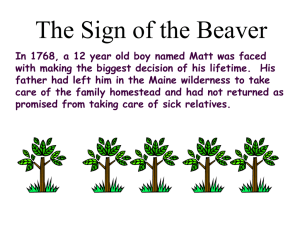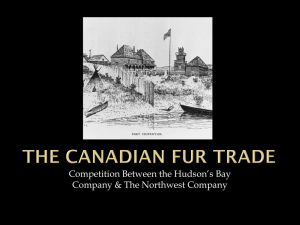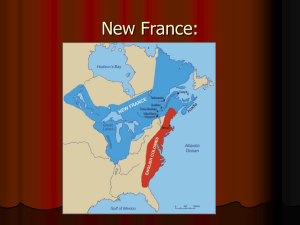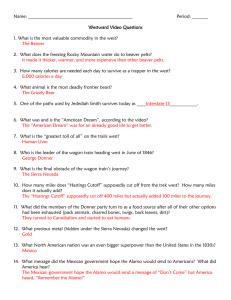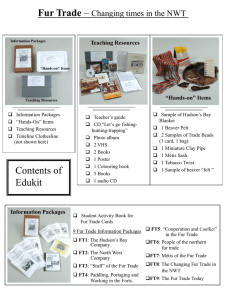beaver pelt
advertisement
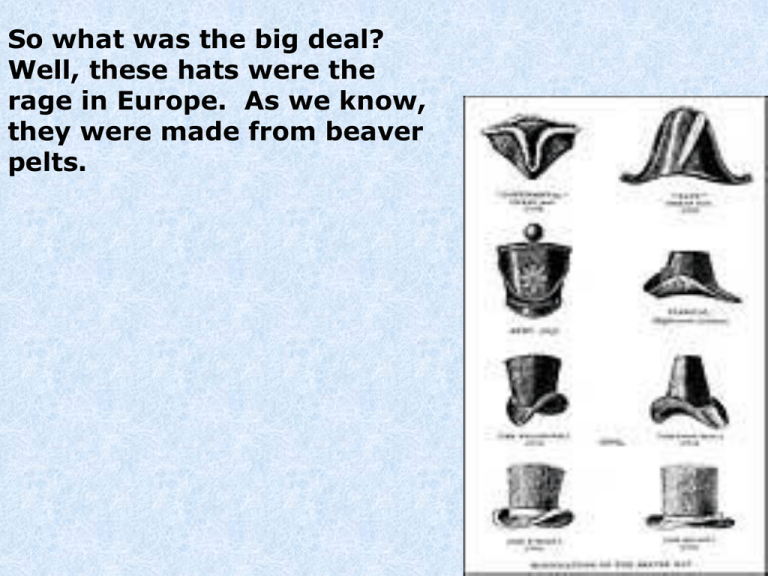
So what was the big deal? Well, these hats were the rage in Europe. As we know, they were made from beaver pelts. This lithograph shows the first public sale of beaver pelts in Europe. Notice the fine clothing of the “gentlemen” present; no poor people allowed! Fashion was what drove the whole fur trade and led to the exploration of the West. This is a picture of 17th century clothing worn by men (with money). This is 18th century wear HBC Fashion…. Then and Now VS. 19th Century clothing Approx. 1940’s/1950’s Finally, somewhat blurry, but this is 2000 style clothing for men This is the “famous HBC coat” (brutal colours) that was revived a few years ago. VS. 18th Century 17th Century VS. Early 20th Century 19th Century Early 20th Century Today, the Bay's mission statement is to be "Canada's leading fashion department store". The women's wear division has developed into a multi-million dollar business emphasizing brands such as Liz Claiborne, Jones New York, DNKY, Ellen Tracy, Guess, Levis, Nygard and Elite VS. Cartier, of course, was one of the first to explore the East Coast of what is now Canada. However, it was the man in the red above (Charles II) who gave his cousin Rupert the land that became known as “Rupert’s Land”. Rupert (to the right) then leased it to the Hudson’s Bay Company. “All the rivers draining into the Hudson Bay” and the lands surrounding these rivers was known as Rupert’s Land. The North West Company was formed in 1783 by fur traders from Montreal. Many of the Nor'westers (as they were known) were former coureurs de bois. After the French lost New France to Britain in the Seven Years War, they had nobody to work for. Others were young men who had come from Scotland to join the fur trade. Hudson's Bay Company faced fierce competition from the North West Company. Both companies wanted to control the fur trade. As a result, a bitter rivalry developed. By the 1800s the two sides were at war with each other. It was a fur trade war. In order to control the fur trade, it was important to find new trading partners. Soon both companies sent out people to explore and find new sources of fur. This meant traveling in unknown wilderness both on dangerous rivers and difficult land routes. Howard Kelsey trading with Eskimos Alexander Mackenzie discovering the Pacific Howard Kelsey (an explorer) seeing the buffalo on the plains for the first time. There were two fur-trading networks. One route was along the Ottawa and St. Lawrence River. The other was the Hudson Bay route. The Hudson's Bay Company used the Hudson Bay route in the north, which was a better route. The Nor'westers used the one in the south to Montreal. The Nor'westers and the Baymen would sometimes use any means to win control of the fur trade. They destroyed each other's boats and forts. They tried to bribe the other company's traders and offered more money for the furs. Some of the men even used violence and murder to get more fur. The two sides fought each other from the 1780s until 1821. Both companies were spending all their money and energy competing with each other. The war was ruining both companies, but the North West Company weakened the most - especially after the Battle of Seven Oaks. The text below comes from the Albany Fort America Journal of 1706: Remains trading goods as per balance of last year’s Account 154 powder horns 430 lbs powder 144 painted boxes 8477 lbs shot 83 tobacco boxes 149 kettles and 79 pair ditto tongs 21 pans 8108 pewter 221 lbs beads buttons 1/8 2 lbs vermillion 78 ice chisels 96 lbs red lead 14 scrapers 1/2 60 lb thread 71 leather looking glasses 78 guns: 52 of 4 12 tin shoes foot and 26 of 440 haws bells 41/2 foot long 67 iron wire 15 pistols handcuffs 15642 flints 24 horns for men’s 6 sword blades heads 29 bayonets 24 pairs yarn gloves 308 fire steels 37 pairs cargo breeches 691 worms 03/4 yards 700 needles broadcloth 50 yards baize The beaver pelt became a currency. There were even tokens made. Items to be traded were measured against the value of a beaver pelt. HBC established a system that calculated how much one "made" beaver pelt was worth compared to other furs and goods. HBC traders and Aboriginal hunters and trappers would each try to get more than the standard allowed. SuppliesValue of Supplies in Beaver Pelts 2.25 kg of sugar 1 beaver pelt 1 gun 12 beaver pelts 2 scissors 1 beaver pelt 20 fish hooks 1 beaver pelt 1 pair of shoes 1 beaver pelt In general, beaver pelts were worth a lot more than other pelts. Below, is a small table showing the values for some species. Beaver Pelts Other Pelts 1 equals...2 otters 1 equals...2 foxes 1 equals...1 cat 1 equals...1 wolf 2 equals...1 moose 1 equals...1 black bear 1 equals...2 deer This is a made beaver pelt and it was worth its weight in gold, literally. A view of a trading post located along the Hudson Bay. The Native Peoples were the key to successful trading. Therefore, their customs were much respected, including the smoking of the peace pipe. This is a painting showing a fur brigade portaging or going around a set of rapids and falls. It was very hard work and only the young/strong survived. One of the many fur brigades going through a fairly shallow river. Most voyageurs did not have horses and used large canoes instead. The NWC had its headquarters in Montreal which is where their fur brigades left in the spring. A fur sorting room with a “grader” of furs working.
